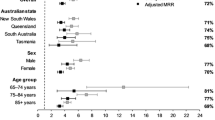Abstract
Background and aims: The aim of the study was to investigate the impact of fractures (i.e., hip, Colles, humeral and vertebral fractures), compared with that of other common diseases requiring hospitalization, on health care in the main hospital in Rome (Italy). Methods: Hospital discharge forms, filled in according to the 9th International Classification of Diseases, were examined from 1996 to 1999. Data on fractures were compared with those related to other diseases which occupy a considerable proportion of hospital operating time in Italy: coronary heart disease (CHD), cerebrovascular disorders (CVD), diabetes mellitus (DM), chronic obstructive pulmonary disease (COPD) and breast cancer (BC). Results: In all groups of patients, the mean age of females was significantly higher (p<0.0001) than that of males. Male patients with hip fractures had hospital stays significantly longer than females (p<0.0001), whereas women with Colles fractures had significantly (p<0.02) longer stays. When patients were divided according to age (i.e., over or under 60 years), mean hospital stays did not differ between younger and older patients in all groups except Colles fractures (p<0.001). Hip fractures in older patients showed striking in-hospital mortality. Throughout the study period, hip fractures accounted for the highest overall and per-patient costs. The number of female patients with fractures (and, obviously, breast cancer) was higher, while the opposite applied to the other disorders. Male patients with fractures, CHD and CVD were significantly younger than females (p<0.0001). When the percentage of deaths was added to that of patients discharged to other institutions, fractures showed the poorest outcome of any hospitalization event. Per-patient costs were remarkably higher for CHD, followed by fractures. Conclusions: Fractures represent a growing but often underestimated burden for hospital care in Italy; further studies are needed on this issue.
Similar content being viewed by others
References
Langlois JA, Maggi S, Crepaldi G. Workshop on hip fracture registries in Europe. Aging Clin Exp Res 2002; 12: 398–401.
Minisola S, Grossi C. Quality of life issues in patients with osteoporotic fractures. Aging Clin Exp Res 2002; 14: 60–3.
Butler RN. Population aging and health. BMJ 1997; 315: 1082–4.
Fried LP. Epidemiology of aging. Epidemiol Rev 2000; 22: 95–106.
ISTAT. Population projections by sex, age and region. Base 1.1.1996. Roma, 1997; 34.
Karagas MR, Lu-Yao GL, Barrett JA, Beach ML, Baron JA. Heterogeneity of hip fracture: age, race, sex, and geographic patterns of femoral neck and trochanteric fractures among US elderly. Am J Epidemiol 1996; 143: 677–82.
De Laet CEDH, Pols HAP. Fractures in the elderly: epidemiology and demography. Baillière’s Clin Endocrinol Metab 2000; 14: 171–9.
Wildner M, Casper W, Bergmann KE. A secular trend in hip fracture incidence in east Germany. Osteoporos Int 1999; 9: 144–50.
Assaf AR, Lapane KL, McKenney JL, Carleton RA. Possible influence of the prospective payment system on the assignment of discharge diagnoses for coronary heart disease. N Engl J Med 1993; 329: 931–5.
Bernabei R, Landi F, Zuccalà G. Health care for older persons in Italy. Aging Clin Exp Res 2002; 14: 247–51.
Ljunggren B, Sjödén PO. Patient reported quality of care before vs after the implementation of a diagnosis related groups (DRG) classification and payment system in one Swedish country. Scan J Caring Sci 2001; 15: 283–94.
Dennison E, Cooper C. Epidemiology of osteoporotic fractures. Horm Res 2000; 54 (Suppl 1): 58–63.
Cummings SR, Melton LJ. Epidemiology and outcomes of osteoporotic fractures. Lancet 2002; 359: 1761–7.
Heyse SP, Sartori L, Crepaldi G. Epidemiology of osteoporosis: a study of fracture mortality in Italy. Calcif Tissue Int 1990; 46: 289–93.
Ross PD. Clinical consequences of vertebral fractures. Am J Med 1997; 103(2A): 30S–43S.
Iezzoni LI, Moskowitz MA. Clinical overlap among medical Diagnosis-Related Groups. JAMA 1986; 255: 927–9.
Greco A, Errico M, Annese MA, et al. Can the PPS based on DRG show a new role for internal medicine? CASEMIX 2000; 2: 113–5.
Orwoll ES. Osteoporosis in men. Curr Opin Endocrinol Diabetes 2000; 7: 303–9.
Center JR, Nguyen TV, Schneider D, Sambrook PN, Eisman JA. Mortality after all major types of osteoporotic fracture in men and women: an observational study. Lancet 1999; 353: 878–82.
Fitzgerald JF, Moore PS, Dittus RS. The care of elderly patients with hip fracture: changes since implementation of the prospective payment system. N Engl J Med 1988; 319: 1392–7.
Kanis JA, Delmas PD, Burckhardt P, Cooper C, Torgerson D. Guidelines for diagnosis and management of osteoporosis. Osteoporos Int 1997; 7: 390–406.
Gabriel SE, Tosteson AN, Leibson CL, et al. Direct medical costs attributable to osteoporotic fractures. Osteoporos Int 2002; 13: 323–30.
Johnell O. The socioeconomic burden of fractures: today and in the 21st Century. Am J Med 1997; 103(2A): 20S–6S.
Autier P, Haentjens P, Bentin J, et al. Costs induced by hip fractures: a prospective controlled study in Belgium. Osteoporos Int 2000; 11: 373–80.
Louis DZ, Yuen EJ, Braga M, et al. Impact of a DRG-based hospital financing system on quality and outcomes of care in Italy. Health Serv Res 1999; 34: 405–15.
Clancy T, Kitchen S, Churchill P, Covington D, Hundley J, Maxwell JG. DRG reimbursement: geriatric hip fractures in the community hospital trauma center. South Med J 1998; 91: 457–61.
Author information
Authors and Affiliations
Corresponding author
Additional information
Results partly presented in abstract format at the 1st SIOMMMS Meeting, Milano, Italy, October 3–6, 2001.
Rights and permissions
About this article
Cite this article
Romagnoli, E., Carnevale, V., Calandra, P. et al. Impact of fractures on health care in a major university hospital in Rome. Aging Clin Exp Res 15, 505–511 (2003). https://doi.org/10.1007/BF03327374
Received:
Accepted:
Published:
Issue Date:
DOI: https://doi.org/10.1007/BF03327374




